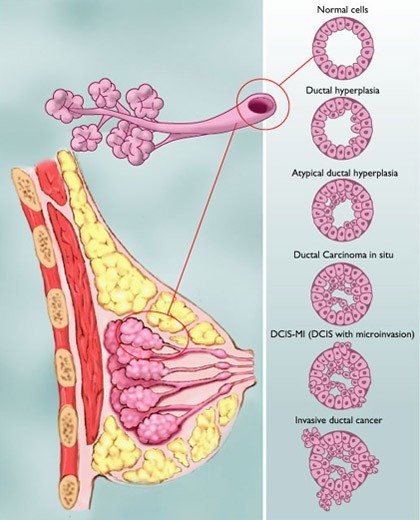
Diagnosed with Cancer? Your two greatest challenges are understanding cancer and understanding possible side effects from chemo and radiation. Knowledge is Power!
Learn about conventional, complementary, and integrative therapies.
Dealing with treatment side effects? Learn about evidence-based therapies to alleviate your symptoms.
Click the orange button to the right to learn more.
Tamoxifen-Related Cancer in Early Stage Breast Cancer

“However, concerns have been raised that the drug (tamoxifen) may increase the incidence of new primary malignancies, such as endometrial, liver, and colorectal cancers.”
You’ve been diagnosed with either DCIS (BC stage 0) 0r early stage breast cancer. Your oncologist has recommended tamoxifen. No big deal. You’ve heard of this therapy. You know of other women who have undergone tamoxifen therapy.
Adjuvant tamoxifen therapy can reduce a woman’s risk of breast cancer relapse in the same breast. This much we know. But, according to the studies linked and excerpted below, adjuvant tamoxifen in early breast cancer patients causes “a nearly sixfold increase in endometrial cancers and a threefold increase in gastrointestinal cancers…”
So the question to consider is the risk/reward ratio of adjuvant tamoxifen therapy. Are there evidence-based non-toxic therapies that also reduce the risk of BC relapse?
Consider two possible therapy plans-
- Breast-conserving surgery aka lumpectomy and evidence-based, non-toxic therapies discussed in the DCIS guide.
- Breast-conserving surgery aka lumpectomy, low-dose tamoxifen (linked below), plus the evidence-based, non-toxic therapies in the DCIS guide.
Look. I cannot presume to suggest how you want to treat your body. However, I don’t think that conventional oncology does a thorough job of explaining your options.
Scroll down the page and post a question or a comment. I will reply to you ASAP. Also, please download the DCIS guide linked in the banner above.
Hang in there,
David Emerson
- Cancer Survivor
- Cancer Coach
- Director PeopleBeatingCancer
Recommended Reading:
- Why Breast Cancer Research Can’t Be Trusted
- Surgical Margins and Breast Cancer (both DCIS and Invasive)
- Breast Cancer-Prevent Radiation-Induced Dermatitis- Ugly, Painful Side Effect
Adjuvant Tamoxifen Therapy for Early Stage Breast Cancer and Second Primary Malignancies“
Tamoxifen and secondary tumours. An update. Drug Saf. 1997 Feb;16(2):104-17.
“In women treated with adjuvant tamoxifen the incidence of new primary breast cancers is decreased. This latter observation has led to the initiation of prevention trials. In 1989 the first report from a large prospective randomised trial showed a significant increase of endometrial carcinoma among women treated with adjuvant tamoxifen…
Randomized Placebo Controlled Trial of Low-Dose Tamoxifen to Prevent Local and Contralateral Recurrence in Breast Intraepithelial Neoplasia
“PURPOSE- Tamoxifen administered for 5 years at 20 mg/d is effective in breast cancer treatment and prevention, but toxicity has limited its broad use. Biomarker trials showed that 5 mg/d is not inferior to 20 mg/d in decreasing breast cancer proliferation. We hypothesized that a lower dose given for a shorter period could be as effective in preventing recurrence from breast intraepithelial neoplasia but have a lower toxicity than the standard dose.
PATIENTS AND METHODS-We conducted a multicenter randomized trial of tamoxifen, 5 mg/d or placebo administered for 3 years after surgery in women with hormone-sensitive or unknown breast intraepithelial neoplasia, including atypical ductal hyperplasia and lobular or ductal carcinoma in situ. The primary end point was the incidence of invasive breast cancer or ductal carcinoma in situ.
RESULTS-Five hundred women 75 years of age or younger were included. After a median follow-up of 5.1 years (interquartile range, 3.9-6.3 years), there were 14 neoplastic events with tamoxifen and 28 with placebo (11.6 v 23.9 per 1,000 person-years; hazard ratio, 0.48; 95% CI, 0.26 to 0.92; P = .02), which resulted in a 5-year number needed to treat of 22 (95% CI, 20 to 27). Tamoxifen decreased contralateral breast events by 75% (three v 12 events; hazard ratio, 0.25; 95% CI, 0.07 to 0.88; P = .02). Patient-reported outcomes were not different between arms except for a slight increase in frequency of daily hot flashes with tamoxifen (P = .02). There were 12 serious adverse events with tamoxifen and 16 with placebo, including one deep vein thrombosis and one stage I endometrial cancer with tamoxifen and one pulmonary embolism with placebo.
CONCLUSION-Tamoxifen at 5 mg/d for 3 years can halve the recurrence of breast intraepithelial neoplasia with a limited toxicity, which provides a new treatment option in these disorders…”

